Volume 17 Issue 1
Latest articles
- Researchpp 281-298Ninwijit, T., Palamnit, A., Luengchavanon, M., Marthosa, S., Osman, N., Chowdhury, M. S., and Niyomwas, S. (2022). "Analysis of electric signals from micro-solid oxide fuel cell sensors detecting methane biogas," BioResources 17(1), 281-298.AbstractArticlePDF
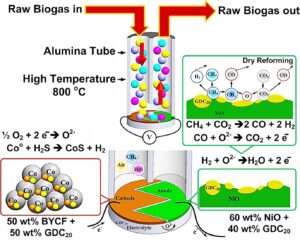
Micro-solid oxide fuel cells (SOFC) sensors prepared via depositing a thin film BYCF (10 wt% [Ba0.95FeY0.05O2.8] + 90 wt% [Co2O3]) – GDC20 (Gd0.20Ce0.80O1.95) cathode and NiO-GDC20 (Gd0.20Ce0.80O1.95) anode on a GDC20 electrolyte layer were operated at 800 °C. The structure, which receives only biogas, was formed into 15-mm pellets with only one side for detecting methane (CH4). The detection of 40% to 99.99% CH4 provided a high level of accuracy compared with 10% to 30% CH4. The biogas (60% CH4) from the Oil Palm Industry and Rubber Cooperative Fund, Thailand, increased remarkably at voltage levels of 20 to 21 mV. The electrical signal from the micro-SOFC sensor corresponded to the quantity of CH4, with the chemical reaction of the dry reforming activities (NiO and Co3O4) highly catalyzed and transformed from CH4 to H2, thus generating electrons. It was concluded that the micro-SOFC sensor is suitable for detecting methane measurements at intermediate temperatures, with the ceramic structure offering low degradation compared with metal sensors.
- Researchpp 299-315Ab Latib, H., Ratnasingam, J., Mariapan, M., Othman, K., Amir, M., Choon Liat, L. C., Lee, Y. Y., Ioras, F., Farrokhpayam, S. R., and Jegatheswaran, N. (2022). "Malaysian timber industry policy: Achievements, challenges, and lessons learned," BioResources 17(1), 299-315.AbstractArticlePDF
The National Timber Industry Plan was the first major dedicated policy framework for the wood products industry in Malaysia. This plan aimed to transform the industry into a high value-added products manufacturer and exporter, with a targeted export value of USD 13 billion in 2020. Unfortunately, this target was revised downwards in 2017 due to stagnating growth; in 2020, wood products export was valued at USD 5.43 billion. A survey of 914 different wood products manufacturers, involving sawmillers, molding, furniture, and joinery manufacturers, were conducted to examine the constraints faced, and the weaknesses of the policy framework that hampered its intended objectives. The results revealed that the policy framework did not have much impact on transforming the industry, and its growth continued to be fueled by incremental factor inputs, rather than by productivity gains. Uncertainty with the policy framework, especially with addressing raw materials supply and workforce, were highlighted as the two most important constraints faced. In essence, the outcomes suggest that business confidence, associated with industrial growth factors, are the prerequisite for the policy framework to succeed, and if confidence falters, it will adversely affect the targeted outcome of the policy.
- Researchpp 316-328Lin, L.-D., Tsai, M.-J., Chang, F.-C., Ko, C.-H., and Yang, B.-Y. (2022). "Influence of torrefaction on the heating values and energy densities of hardwood and softwood," BioResources 17(1), 316-328.AbstractArticlePDF
Lumber manufacturing facilities generate large amounts of wood residues as a by-product of processing. In this study, the torrefaction characteristics of the Cryptomeria japonica and Acacia confusa residues were evaluated and compared to microcrystalline cellulose. The torrefied products also were analyzed. The results showed that the higher heating value (HHV) of the C. japonica and A. confusa residues increased to 5,993 and 5,576 kcal/kg after 20 min of torrefaction at 310 °C, which was higher than the microcrystalline cellulose (4,340 kcal/kg). The energy densification of the torrefied biomass could rise to 1.17 to 1.20 times higher than the raw biomass. The condensable gaseous product was an organic acid liquid. The liquid product consisted of some alkanes, alcohols, esters, and amides. The exothermic temperature would be reduced after torrefaction. Additionally, the thermal treatment of the biomass destroyed the cellulose crystals and reduced the cellulose crystallinity index. In order to reduce the usage of fossil fuels, the torrefied solid biomass could be mixed with coal in power plants directly.
- Researchpp 329-341Choowang, R., Thitithanakul, S., and Luengchavanon, M. (2022). "The fabrication and performance of plantable bio-pots from thick sheets of oil palm trunk," BioResources 17(1), 329-341.AbstractArticlePDF
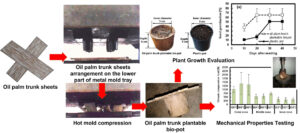
The oil palm trunk contains great nutrients for plant growth, and its supporting cells are mostly parallel to the centerline. This study investigated the fabrication of a plantable bio-pot from 5 mm thick sheets of oil palm trunk. The effects of the three zones in the trunk (outer, middle, and inner) and the pressing mold temperature in the range from 160 °C to 200 °C on characteristics of a bio-pot were evaluated. The results demonstrated that the outer zone of an oil palm trunk with 200 °C molding temperature had the highest ultimate compression load, and the pot shape appeared stable after soaking in water for 24 h, showing 105% water absorption. The changes to oil palm trunk chemistry caused by elevated temperature contributed to the mechanical properties and improved durability. The oil palm trunk plantable bio-pots facilitated germination of chili and eggplant seeds. The leaf number, leaf greenness, plant height, and total dry biomass had no significant difference between using the oil palm trunk bio-pot and a plastic pot for a seedling of either of these plants.
- Researchpp 342-354Rezanezhad, S., Nazarnezhad, N., Resalati, H., and Zabihzadeh, S. M. (2022). "The use of gluconic acid as an additive in magnetic paper," BioResources 17(1), 342-354.AbstractArticlePDF
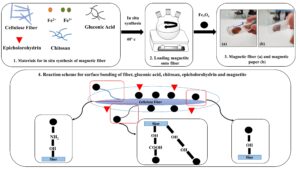
As magnetic fillers, e.g., nanomagnetite, reduce the mechanical strength of produced magnetic papers, additives should be used. In this study, nanomagnetic papers were produced through an in-situ method by synthesizing magnetic cellulose fibers with kraft fibers and iron salts in a nitrogen atmosphere. Then, gluconic acid was added to improve the mechanical strength. The properties of nanomagnetic papers were investigated via different methods. The nanomagnetite particle size ranged from 1 to 84 nm. Scanning electron microscopy demonstrated the deposited nanomagnetite particles on the surface of the fibers. The saturation magnetization of the nanomagnetic papers treated with 0%, 1%, 2%, or 3% gluconic acid (per dry weight of the pulp) was 7.54, 5.64, 4.81, and 0.55 emu/g, respectively. The nanomagnetite particles loaded on the fibers decreased as the gluconic acid content was increased. The nanomagnetic papers exhibited superparamagnetic behavior. Elevation of the gluconic acid content caused an increased tensile and burst index, as well as a reduced tear index. It also led to augmented brightness and diminished opacity.
- Researchpp 355-368Hu, X., Dong, S., Han, H., Gao, Y., and Zhang, B. (2022). "Screening of highly efficient fungi for the degradation of lignocelluloses by ionic liquids-assisted cellulase," BioResources, 17(1), 355-368.AbstractArticlePDF
A successful conversion of lignocellulosic biomass into biofuel could be achieved through an ionic liquids (ILs)-pretreatment and an enzyme saccharification. In this study, the fungal strains with high cellulase productions were isolated and identified as Penicillium janthinellum FHH1 and P. oxalicum FLY4. A high cellulase production was obtained at pH 4.0 and 30 °C for P. janthinellum FHH1 with corn stalk and beef extract for 9 days and for P. janthinellum FHH1 with corn stalk and peptone for 7 days. A pH range between 4.0 to 6.0 and a temperature range from 55 °C to 60 °C were applicable for cellulase with high activities during hydrolysis. A high NaCl-stability and a relatively high ILs-stability were found for cellulase obtained from P. oxalicum FLY4. High yields of reducing sugar were obtained by enzymatic hydrolysis of the original corn stalk and ILs-pretreated corn stalk. P. oxalicum FLY4 has a great potential for ILs-assisted fungi in the degradation of lignocellulosic biomass into value-added products.
- Researchpp 369-383Mandiringana, M., Matakala, M., Mwanabute, N. P., Ngoma, J., and Ncube, E. (2022). "Analysis of the factors limiting the performance of small-to-medium scale sawmills in the copperbelt of Zambia," BioResources 17(1), 369-383.AbstractArticlePDF
Small-to-medium scale softwood sawmills in the Copperbelt of Zambia are operating below 50% capacity. The timber supply is uncertain as demand continues to increase in tandem with economic activities and population growth. This study identified the financial, i.e., access to finance and operating costs, and non-financial, i.e., raw material, transport, skilled labor, and sawn timber recovery, as the limiting factors affecting performance. The authors benchmarked various financial ratios, i.e., gross profit margin, net profit margin, return on investment, return on capital employed, and working capital turnover, of the small-scale sawmills compiled from survey data with the average industry ratios. Raw material is the most limiting factor affecting profitability/success of small-scale sawmills. A Cobb-Douglas model demonstrated that sawn timber recovery depends on operator skills, particularly in non-automatic machinery, which are common. Strategies currently employed are value addition, multiple sourcing, equipment acquisition and modernization, and labor cost reduction. Measures proposed to enhance profitability are credit guarantee schemes, collaboration, tax reduction, lesser-used timber utilization, and timber auction floor.
- Researchpp 384-399Zhou, J., Gao, G., Li, Y., Wang, D., Hu, J., Song, Y., and Chen, P. (2022). "A method of hydrophobically modifying paper with a trace reagent," BioResources 17(1), 384-399.AbstractArticlePDF
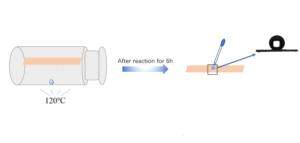
It is of great importance to protect paper cultural relics, especially in terms of making them waterproof. One of the important ways to protect paper cultural relics is by hydrophobic modification treatment. However, most of the existing hydrophobic modification methods rely on a great deal of organic solvents, which poses greater risks to safety and pollution. In this work, a simple, green, and effective method for paper hydrophobic treatment was proposed and evaluated. The vapor of a fluorinated triethoxysilane was reacted with the active hydroxyl group on the paper in a closed space, which realized the hydrophobic modification of the paper in one step. The contact angle of the hydrophobic paper prepared by this method was 148.4° under optimal experimental conditions. In addition, this method did not damage the paper, based on the results of the scanning electron microscopy of the paper before and after hydrophobic treatment. The generality of this method was verified by using other substrates and hydrophobic reagents. This method is simple to operate and does not require the usage of a large amount of organic reagent. It is expected to receive widespread attention in the field of the protection of paper and wooden cultural relics.
- Researchpp 400-410Liu, P., Zhou, Q., and Tian, J. (2022). "A two-variable model for predicting the effects of moisture content and density on the mechanical properties of Phyllostachys edulis bamboo," BioResources 17(1), 400-410.AbstractArticlePDF
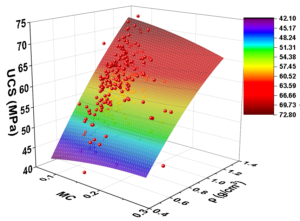
Phyllostachys edulis bamboo is one of the most valuable bamboo species in the world. It has the following advantages: high strength, light weight, and green, renewable character. In addition, it has a broad application prospect under the background of developing green buildings all over the world. The moisture content and density are the key factors affecting the mechanical properties of bamboos. However, there is no two-variable model of the mechanical properties with respect to the moisture content and density of P. edulis bamboo. In this paper, analysis of the compression parallel to the grain, bending, tensile parallel to the grain, and shear parallel to the grain of P. edulis bamboo were performed. The relationship between the mechanical properties and the moisture content and density was fitted by a two-variable model. The results show that the two-variable model has good fitting effect. As such, the two-variable model can be used to predict the mechanical properties of P. edulis bamboo according to its moisture content and density.
- Researchpp 411-428Lee, C.-G., Kim, M.-J., and Eom, C.-D. (2022). "Kinetic study of torrefied woody biomass via TGA using a single heating rate and the model-fitting method," BioResources 17(1), 411-428.AbstractArticlePDF
A model-fitting method at a single heating rate (10 °C·min-1) was used to investigate the thermal kinetic characteristics of torrefied woody biomass. The kinetic parameters were examined for pine, oak, and bamboo samples with the order of the reaction set ranging from 0.1 to 0.5 and 1.0. Based on the thermogravimetric, derivative thermogravimetric, and derivative2 thermogravimetric curves obtained, the ranges at which substantial hemicellulose and cellulose pyrolysis occurs were set as the analysis range, and the kinetic parameters of each species were analyzed. The activation energy and pre-exponential factor were obtained at these analytical ranges using two differential methods (Friedman and Chatterjee-Conard) and an integral method (Coats-Redfern). Although there were numerical differences between the results of the differential and integral methods, the thermal properties of each sample exhibited a consistent trend. Softwood was found to have the highest reactivity and intermolecular collisions per unit weight during thermal decomposition. In the case of the torrefied oak and torrefied bamboo, considering that the carbon content and fixed carbon content were approximately 24% to 25% higher than the softwood, it is appropriate to consider the thermal characteristics of each species for producing a solid fuel based on the application.
